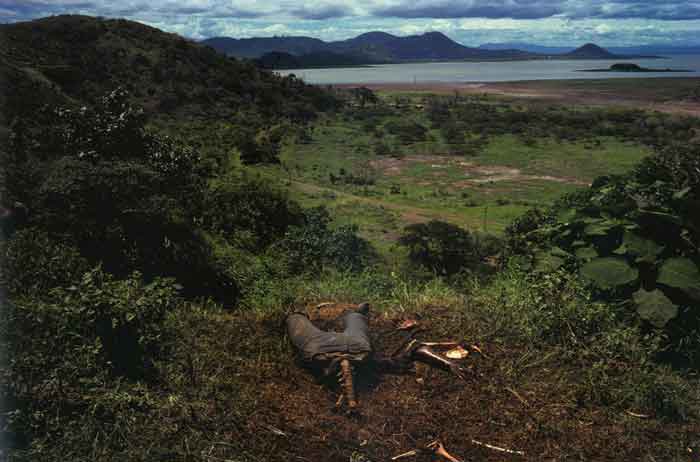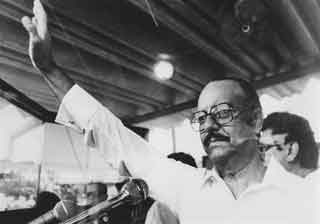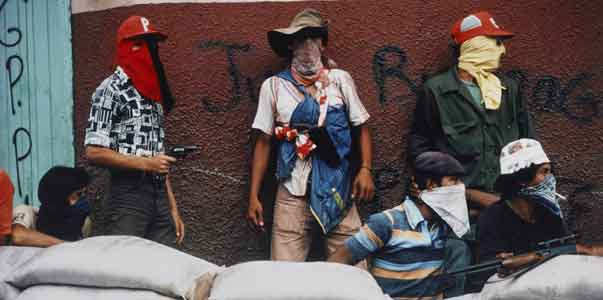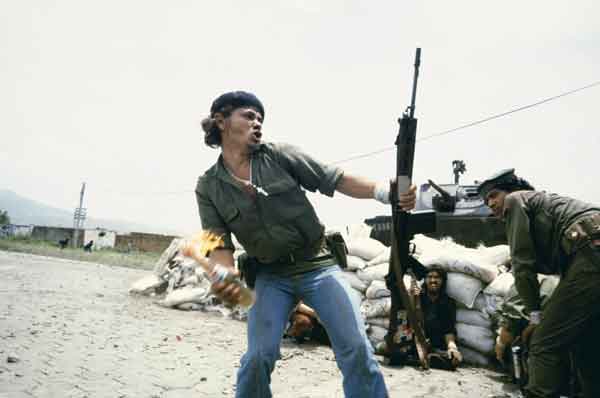 Susan Meiselas's iconic photograph "Cuesta del Plomo", hillside outside Managua, a well known site of many assassinations carried out by the National Guard. People searched here daily for missing persons.
Susan Meiselas's iconic photograph "Cuesta del Plomo", hillside outside Managua, a well known site of many assassinations carried out by the National Guard. People searched here daily for missing persons.
Nicaragua under the Somozas had been a reliable U.S. ally, but slipped through its grasp as the greediness and ghoulishness of Anastasio ("Tachito") Somoza Debayle turned pathological and became a gross liability to the United States.
A typical drill of Somoza's infamous National Guard:
"Who is the Guardia?"
"The Guardia is a tiger."
"What does tiger like?"
"Tiger likes blood."
"Whose blood?"
"The blood of the people."
The counterinsurgency experts in Washington learned from the Cuban
experience as well, but were unable to convince President Jimmy Carter
that human rights should not become a factor in determining US policy
toward its traditional spheres of control. Carter, because it was a matter
of faith, made human rights a leitmotif of his foreign policy.

Anastasio ("Tachito") Somoza
Somoza was confused by Carter's apparent sincerity on the human
rights issue. His family had been installed in power by President Franklin
Roosevelt, the man who also had made human rights the center piece
of US policy in his Four Freedoms address during World War II. But
Roosevelt had never bothered the Somoza clan with complaints about
human rights violations. After all, forty-five years of anti-communist
obedience should have counted for more than a few cases of maltreating
radical trouble makers.
When Somoza finally realized that Carter was serious, he found
himself in an impossible position. To lift martial law for the purpose of
continuing to receive US aid and legitimation would also mean allowing
the FSLN to have the necessary space to organize throughout the
country. To abide by Carter's principles would require Somoza to leash
and muzzle the National Guard; to remove from it the very instruments
by which it had succeeded in terrorizing the population.
Somoza paid lip service to human rights, hoping that it would appease
the US ambassador, while at the same time he ordered the Guard to
wipe out Sandinista influence in me poor barrios and the Christian
based communities where the priests and nuns were applying their
revolutionary theology. However, the ambassador did not turn the other
way in 1977 and 1978 as Guard members murdered, tortured, raped
and looted their way through the barrios and rural areas. US officials
denounced the abuses, threatened to cut off aid, and eventually did so
in 1978. Subsequently writing from exile in Paraguay in the 1980s,
Somoza charged: 'Our nation was truly delivered into the hands of the
Marxist enemy by President Jimmy Carter and his administration. I was
betrayed by a longstanding and trusted ally.' Somoza had a point. Having
labeled the FSLN communists, and received encouragement and support
from right-wing friends in the US military and in Congress for forty
years, Somoza could not believe that the United States would allow the
'communists' to triumph.
But Carter believed he had a mandate to restore US credibility after
the stains left by the Vietnam War and the revelations of CIA
shenanigans - including its support for corrupt and brutal dictators.
The era of world politics had passed when American presidents could
with impunity maintain the Somozas of the Third World as reliable
clients.
Since Somoza had no desire to transform himself and his Praetorian
Guard into anything that could conceivably qualify as democracy, he
chose more repression. He thought that by increasing the level of
brutality the Guard could cow the populace back into obedience. He
was wrong. The more brutal the Guard's behavior, the more resistant
the populace grew. As Guard units marched through the barrios, or
randomly shot poor teenagers and middle-class youth, fear turned to
outrage. People who for decades had accepted the savageries of the
Guard could tolerate no more.
Inside Nicaragua and in the United States, the anti-Somoza forces
coalesced. Illiterate peasants and local merchants in Nicaragua found
themselves allied in the struggle against Somoza with exiled dish
washers in Houston and University of California students. Some became
guerrillas, while others served as lobbyists, pamphleteers, or fund raisers
in Washington. A group of well known professionals and business
executives formed 'Los Doce', a group of twelve reasonable and
responsible moderates who appealed to middle-class opinion throughout
the world to join in with money and moral support to oust the dictator
and his hated Guard.
In January 1978, an event occurred that galvanized the fragmented
anti-Somoza opposition. Pedro Joaquin Chamorro, the dynamic editor
of La Prensa, Managua's leading daily, was assassinated. The popular
Chamorro had openly published demands for Somoza's removal, and
called for broad national unity. Although lacking direct proof, most
Nicaraguans assumed Tachito had ordered the slaying. Chamorro, hardly
a leftist, had criticized the FSLN 's radical rhetoric, but the Sandinistas,
nevertheless, joined other anti-Somoza elements, including labor unions,
in organizing mass protests, strikes and demonstrations in response to
Chamorro's murder. By mid-1978 the Church had added its weight to
the growing demand that Somoza resign.
The US government was in the throes of a decisive policy debate.
President Carter faced a choice: Somoza, a flagrant rights violator; or
the FSLN, regarded in intelligence and diplomatic circles as communists,
or, at best, independent leftists friendly to Castro.
'Another Cuba' in Central America was deemed unacceptable, but
the continuation of Somoza rule appeared dubious. National Security
Adviser, Zbigniew Brzinski, feared that by applying human rights criteria
to Nicaragua, the United States would strengthen the revolutionaries.
Since the Guard was loyal to Somoza, not the Nicaraguan Constitution,
Tachito's removal would lead to its disintegration, Brzinksi believed.
The only armed force then remaining would be the FSLN. The human
rights activists inside the administration downplayed the Sandinista
threat and emphasized to the president the importance of maintaining
consistency on human rights. Carter compromised between the competing ideological wings of his administration.
Reversing nearly a century of tradition, President Carter asked Somoza
to step down as a way of ending the civil war, while retaining intact the
National Guard, whose loyalties should logically rum from Somoza to
its next benefactor, the United States. It was not an act of idealism, but
rather a realistic judgment on the part of the president. US intelligence
reports agreed that the tide had turned in Nicaragua and that the
dictator's days were numbered. But Carter's decision came too late for
the national security apparatus to save the Guard. The action on the
battlefields had ensured the Sandinistas their rightful place as heads of
State.
The battlefield included the very center of government in Managua.
On 23 August 1978, eleven months before Somoza fled and the Guard
collapsed, Sandinista soldiers dressed in Guard uniforms arrived in army
trucks at both entrances of the National Palace, where Somoza's
legislature convened. Using their best imitation of Guard officer speech,
they deceived the troops stationed at the doors and other posts. Once
inside, the Sandinistas held captive Somoza's friends, allies and even
family members. For Tachito it was supremely humiliating.
A demoralized Somoza yielded to the Sandinistas' demands for the
release of the Nicaraguan glitterati: $500,000 in exchange for safe
conduct from the palace to the airport, where the captors would be
flown to Cuba, plus the release of fifty-nine political prisoners. Even
National Guard officers winced when Somoza caved in. Morale sank
for a short time.
To revive the fighting spirit of his men, Somoza ordered unprecedentedly
vicious levels of reprisals against the revolutionaries. Inspired
by their palace victory, the Sandinistas called for uprisings. In Matagalpa.
according to the Nicaraguan press, 'armed youths in rebellion' took
over thirty city blocks. The Guard responded with artillery, armored
vehicles and heavy machine-gun fire to retake the neighborhood. On
August 27, the Catholic Church called upon Somoza to resign as 'the
only way to end the current political violence'.
In the final days of August the depressed Tachito regained the
ruthlessness that had made him the scourge of the nation. He purged
Guard officers who had criticized his weakness in bargaining with the
rebels. Charged and found guilty of conspiring to overthrow the
government were eighty-five Guardsmen, including twelve officers. As
for the 'communists and subversives', his name for all revolutionaries,
Somoza told his generals to show no mercy. Sandinisus or suspected
sympathizers were rounded up, tortured, interrogated and then killed.
The Guard carried out fishing expeditions in the barrios, targeting
especially the youth. Thousands of men and women were arrested and
shot simply because they were young. Instead of submitting, the public
were spurred to uncontainable rage.

Matagalpa. Nicaragua, 1978. Muchachos await the counterattack by the National Guard. (Susan Meiselas)
While the human rights advocates and the national security hawks debated policy in Washington, the Guard's ferocity claimed the attention of the world's media. And the Sandinistas, feeling the public pulse, struck. On 7 September 1978 guerrilla units descended from the mountains to launch a major offensive, attacking and holding parts of five major cities. Several thousand Sandinistas took part in the offensive, sending the Guard reeling. Los muchachos (teenagers and children) spearheaded the barrio insurrections.
 Susan Meiselas's "untitled" 1979
Susan Meiselas's "untitled" 1979
In Leon, Grenada, Diriamba, Chinandega, Matagalpa and Managua,
the muchachos joined the uniformed guerrillas. They fought with weapons
stolen from the Guard, sticks, stones and home-crafted Molotov cocktails. Faced with the wrath of the people, the Guard did not flee, but counterattacked with artillery and aeria1 bombing. When the smoke
finally cleared and the Guard regained control, the bodies of young
boys and girls were strewn across the makeshift barricades and trenches.
Commercial and residential areas, schools and churches, looked like
Coventry after days of Axis bombing during World War II. Those
edifices that remained structurally in tact bore the scars of bullets and
shells.
The neighborhood of Monimbo, in the city of Masaya, rose up and
with home-made weapons and rocks held off the heavily armed troops,
then suffered the retaliation. 'We fought against the Guard to save our
lives,' recalled Ernesto Rodriguez Zelaya, a Monimbo mechanic. 'We
realized that after the [Guard's} "mopping up" operation life wasn't
worth anything. Whoever stayed home would be killed! It was easier
for us to grab a rifle and fight with the muchachos than stay home where
we would be just a target for the Guard. So it was the repression that
made us fight, because we didn't want to die.'
In February 1978, Monimbo residents rose again, fought with unbelievable
courage, using paving stones from Somoza's own factory as
weapons, and then faced the renewed vengeance of the Guard.
But even after the continued bombing and shelling of the area, the
Monimbo dwellers refused to submit. The Guard could not regain
control.
The behavior of the Monimbo populace dramatized a larger reality,
one that even jaded members of US intelligence could not escape: the
vast majority of Nicaraguans were prepared to endure immense pain
and suffering to rid themselves of the Somoza family and their Guard.
Tachito understood the people's loathing and responded accordingly.
He ordered his air force to bomb and strafe guerrilla-held cities. Even
after the FSLN had retreated, the air force continued to bomb, to
ensure that the populace would get the message. When the bodies were
counted, the Red Cross announced that over five thousand had perished
from Esteli, Masaya and Leon alone. A further 10,000 were missing;
15,000 were wounded; 30,000 were homeless. Refugees poured into
improvised camps just across the frontiers.
By May 1979 Somoza and his generals decided that the situation
looked bleak, and that if they were to reassume control of Nicaragua,
Masaya was the strategic place to begin. On June 9 the National Guard
began intensive bombing and strafing of Monimbo, 'the pissed off
barrio', as it became known. Following the bombing, a column of
Sherman tanks led Guard foot soldiers through the Sandinista controlled
neighborhoods to retake portions of Masaya.
The guerrillas beat a strategic retreat, but returned unexpectedly three
days later and retook most of the city. For two weeks the battle raged,
block by block. 'The Guard didn't push us out: a Sandinista officer
reported, 'because they didn't receive reinforcements, nor did we take
them out since we didn't have any ammunition.'
On June 24 Guard officers and men abandoned their Masaya
command post, using hundreds of political prisoners as a shield to cover
their retreat. The Sandinistas were in undisputed control of the city,
twenty miles south of Managua. Somoza spent his days in the bunker,
built on top of a Managua hill overlooking the Intercontinental Hotel.
One June evening he met members of the media in an 'off the record'
session. One reporter, nevertheless, recorded the conversation. Why
was he bombing his own people, destroying Nicaraguan property, he
was asked. 'What do you know about underdevelopment?' he slurred,
showing the effects of a day of drinking. 'My people are a bunch of
lazy, stupid, underdeveloped assholes.'
In late June, Tachito ordered his bombers to drop 500 pounders on
densely populated Managua neighborhoods. The Sandinistas, who had
taken the poor barrios from the Guard, immediately retreated to Masaya,
but the muchachos who survived the bombings continued to snipe at and
ambush the Guard in the capital. The US ambassador demanded that
Somoza resign, hoping that it was still not too late to save the Guard
except for its most notorious officers. Apart from unwavering support
from the Israeli government - of which Somoza had been a loyal supporter - and a few cohorts among the remaining Latin American
dictators, Tachito was isolated.
He knew the war was over, but nevertheless ordered his air force to
continue bombing. His family had stolen hundreds of millions of dollars
from the Nicaraguan people, and Tachito expressed his attitude toward
his victims as if to make a final statement that would etch into
Nicaraguan memory the essence of the cruelty that had characterized
the forty-five years of Somoza clan rule.
On July 17 the Somoza family fled to Miami, Florida. Without
Somoza's presence, there was nothing to hold the Guard together.
Overwhelmed and demoralized, the once invincible National Guard
collapsed. Some units surrendered to FSLN commanders, others fled
as one or in ragtag fashion to borders north and south. On July 19 the
Sandinistas held state power.
The Nicaragua Revolution triumphed, like the Cuban one twenty
years earlier, not just because of the Sandinistas' astute military strategy
and tactics employed, or the mistakes of the National Guard. A peculiar
conjuncture of events and times also created a setting on which the
decisive battles were fought. In Washington, the human rights element
in the administration temporarily obstructed national security interventionists;
Costa Rica provided unusual levels of help for the Sandinistas,
thanks to Somoza's 'bad neighbor' policy toward the San Jose
regime; in Cuba, a Solomon-like Fidel Castro persuaded the rival factions
of the FSLN to bury their ideological differences and unify.
The revolution could not have triumphed without the ambivalence
of President Carter, just as its subsequent programs could not be realized
without a similar kind of vacillation from the Reagan administration.
The Sandinistas captured world opinion, an intangible factor that
nevertheless wove its way through White House thinking and mass
media concepts and images. Somoza had made fundamental errors in
judgment. His tactics had alienated even the wealthy, who had for
decades accepted the caprices of his family rule.
The Somozas had accumulated more than 5500 million during their
dynastic rule. They possessed one fifth of Nicaragua's arable land and
more than one hundred and fifty businesses. In addition, the family had
accounts and assets in the United States and Europe that were believed
to be more than double what they owned in Nicaragua. Somoza believed
that as long as the United States was interested in maintaining its
hegemony, the US government would protect him. Tachito's contempt
for his own countrymen and women was so great that it did not occur to him that Nicaraguans could play a role in determining the fate of
their nation.
THE GUERRILLA WARS OF CENTRAL AMERICA, Saul Landau